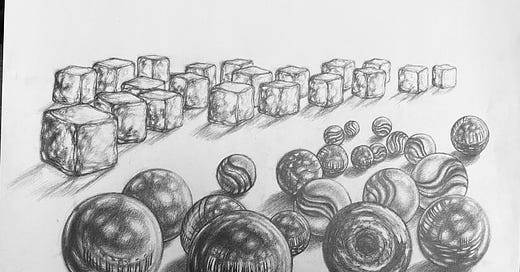An Imaginative Work: Ice cubes and Spheres
Whenever we draw something or observe something so carefully as if we are drawing it, our visual library starts recording and learning. Creating your drawings from imagination takes practice and a visual library about the topic.
An artist’s visual library is basically the collection of visuals in a person’s head. Every person’s visual library is different because we all have our own experiences and things we enjoy keeping in our heads.
For this drawing, I wanted to create an interesting composition that does not exist in the real world. I started drawing with a bunch of cubes, which would later turn into ice cubes. In front of the cubes, I started placing circles that would later turn into spheres. The whole process was kind of enlightened during the process. I was not planning to add cubes while I was drawing the spheres, but then I had the idea of separating cubes and spheres symmetrically. I knew that the cubes were only going to be made up of ice, but I had drawn way too many spheres, and I did not want them to be just identical in texture. I wanted to make some of them look like glass marbles, some like metal spheres, and some of them I challenged myself to make more interesting spheres:
Drawing the cubes as if they were in the same plane was challenging because cubes have flat surfaces. However, for the spheres, since they were going to be differently sized, I noticed that putting them kind of randomly in the paper did not matter, as long as I placed them generally getting smaller as the view goes back, it did not matter too much.
When giving the ice texture to cubes, and metal texture to some spheres, my visual library came into play. Because I had looked into a bunch of ice pictures beforehand, and observed ice in real-world from before, I had some sort of an idea about the shading I wanted to put the make the cubes look like ice. In addition to that, I can confidently say that my background in drawing different types of spheres allowed me to create 2 interesting orbs in this drawing. Even though the orb was glass, the principle to creating it was similar to creating an opaque sphere: The part that does not receive light directly should be slightly darker, there should be small glowing parts where the glass focuses the light. I did not think too much on its mathematics, but applying this general principle got me a 3D glass orb.
This drawing is important to me, because it signifies that my visual library is improving, and that I can recall some information from it when I need to.
Even though the forms I used in this drawing are very basic, with the right shading, I think even the most basic forms can have an aesthetic beauty, and I believe I have achieved that with this drawing.
I believe one of the best ways to test if I understand a concept in drawing is to just try and create a work from my imagination. As I continue expand my visual library, I hope to create more imaginary works with different subjects.



